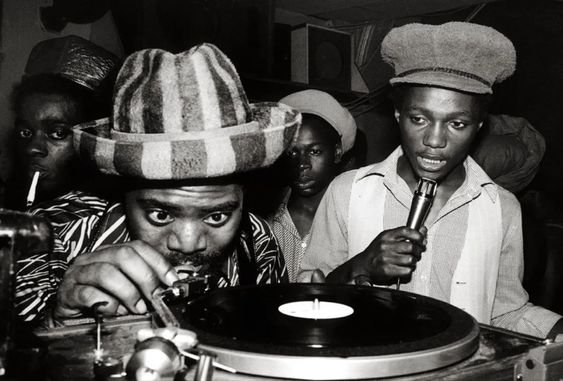EPISODE 02: JAMAICAN SOUND SYSTEMS
Greetings dear nerds, hope you guys are having hot fun in the summertime. I don’t know about you, but my listening is definitely a bit seasonal, with my reggae records getting more play this time of year. I’m really excited to be visiting Jamaica and it’s Sound System Parties in our episode today.
The sound system parties began on the streets of Kingston, Jamaica, in the 1950s. Because very few people had the money to buy records, the main way that people were introduced to new music was either in dancehalls or at street parties. Therefore, whoever owned and operated the portable sound systems was in a position of influence when it came to setting musical trends.
The sound systems, often just referred to as a “sound”, were huge mobile sets of amplifiers and loud speakers designed to play records in open air with as much impact as possible. Jamaicans were hugely interested and inspired by American music at the time; the original DJs, or as they called them in Jamaica, the “Selector”, gave themselves aristocratic titles like ‘Duke’, ‘Count’ or ‘King’. No doubt influenced by American big band and swing of the 1940s and 1950s.
These various sounds owned by the self-appointed Dukes and Kings started out as in informal rivalry to be the best and loudest sound in town. The competition involved two or more sound systems battling to produce the best selections, performance and volume to be crowned victorious by the partygoers.
Towards the end of 1950s, there started to be noticeable lack of the kind of American records which the dancehalls loved best, as the US started to move towards a smoother sound. The sound system men realized they needed to find their own local sound and started recording exclusive tracks to be played at the parties. Initially, they mostly copied the southern soul tunes of Memphis and New Orleans. The distinctly Jamaican sound crept in as the local musicians who played on these track started to over emphasize the slightly crooked shuffle beat of New Orleans rhythm and blues, and the producers began to turn the bass up. Jamaica gained independence from Britain in 1962, and this post war period is a culmination of a lot of socio-economic and cultural factors molding the trajectory of music in the country— poverty from colonization, national pride and the rise of Rastafarianism*. Jamaicans were looking for a more progressive sound that reflected their cultural identity post independence – thus reggae is born.
A note about the term “reggae” – it actually refers one specific genre on the timeline, but is commonly colloquially used an umbrella term for any popular Jamaican music. It was first coined by Toots and the Maytals in their 1968 single “Do the Reggay”. In this show we’re going to hang out in my personal favorite zone for Jamaican music, which is the 60s and 70s, and a little bit into to early 80s and we’ll hear ska, rocksteady, reggae, lover’s rock, and dance hall, and I just wanted to note the stylistic differences.
These days, engineers and DJs still use principles first developed by Jamaican visionaries, and sound system culture is still alive and well in Jamaica. I haven’t been, but I’m really hoping to go next year. If you’ve been, please send your recommendations and travel tips.
British reggae historian and writer Steve Barrow said—
“The fact is reggae has nourished dance culture to an extraordinary degree. I’m not saying anything so banal as “everything sounds like reggae” – it’s in the techniques, and it’s in the forms that have arisen out of Jamaican music. In all of this, this little island has had profound influence”
*Rastafarianism is both a religion and a cultural movement based on the 1930s teachings of Marcus Garvey, who led a back to Africa movement and prophesized that the God of Ethiopia, or Jah, would deliver the black man from his suffering. Rastas regard Haile Selassie, who was the emperor of Ethiopia from 1930 to 1974, as the second coming of Jesus (or Jah), and often claim the flag for the Empire of Ethiopia that was used during his reign. It’s yellow, green, and red with the conquering lion of Judah in the middle.
Track List:
Reggae Recipe – Desmond Dekker and the Aces
Roots Train – Junior Murvin
Better Must Come – Delroy Wilson
On the Beach – The Paragons
Dub Waltz – King Tubby
Dub It – The Upsetters
Your Teeth in My Neck – Scientist
Boneman Connection – Nicodemus
Long Shot Kick De Bucket – The Pioneers
Sweet and Dandy – Toots and the Maytals
Bam Bam – Sister Nancy
Firehouse Rock – Wailing Souls
Liven Up Yourself – Bob Marley
Hail Selassie – Laurel Aitkin
Jah Will Cut You Down – Earth & Stone
Fisherman – The Congos
Barbwire – Nora Dean
Stay Loose – Hemsley Morris
I’m Still in Love With You – Marcia Aitkin
I Shall Sing – Judy Mowatt
A Place Called Happiness – Rudy Mills
Shing a Ling – Desmond Dekker and the Aces
Dreader than Dread – Honey Boy Martin
Train to Skaville – The Ethiopians
Baby – The Heptones
Additional Recommended Viewing: Roots Rock Reggae by Jeremy Marre
Dancers on a Kingston Street in the 1950s.
Setting up a sound system.
The DJ grabs the mic. In Jamaica, a DJ is what we call an MC in the USA. What we call a DJ in the USA, is called a Selector in Jamaica.
Sifting through probably both American and Jamaican records.
King Tubby, Jamaican visionary producer who pioneered many revolutionary techniques still used by DJs and producers all over the world today.
Dancing into the 1960s.





